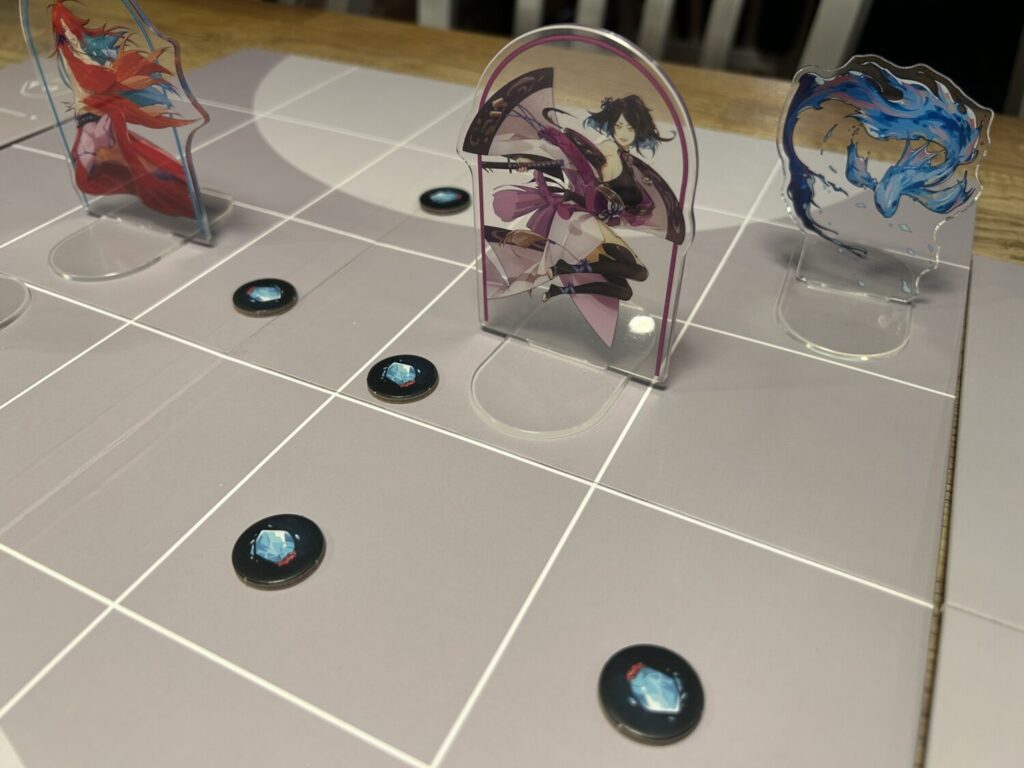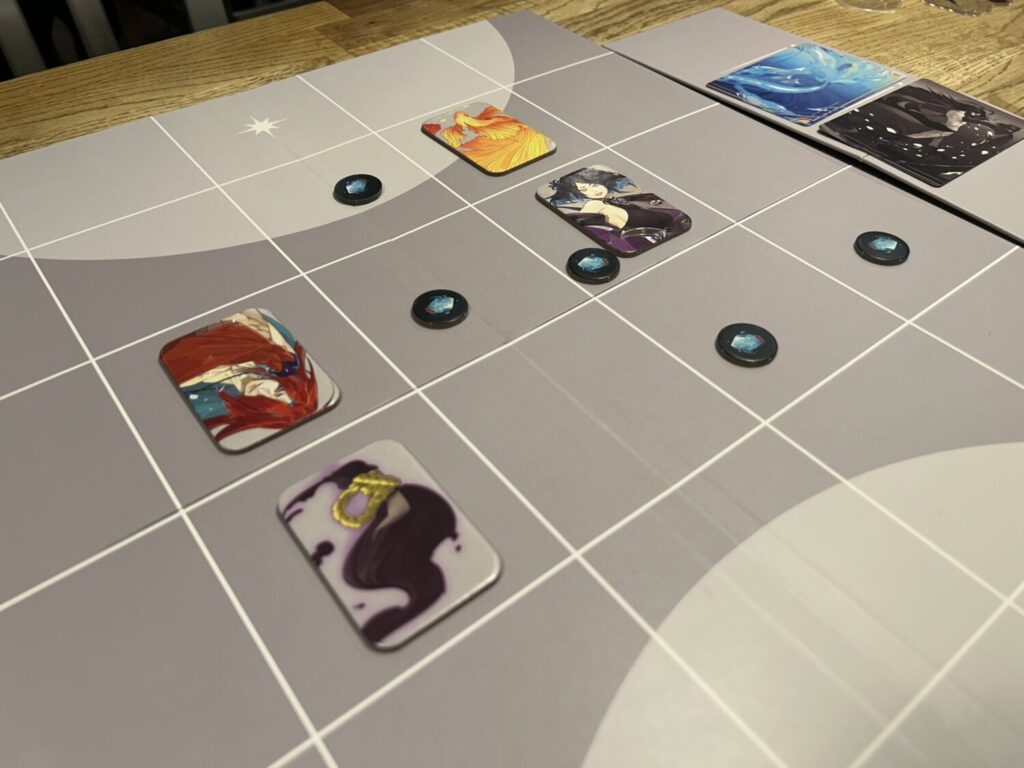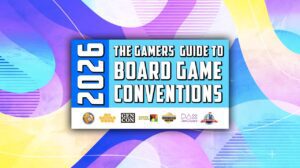Disclosure: Meeple Mountain received a free copy of this product in exchange for an honest, unbiased review. This review is not intended to be an endorsement.
Do you like punishing games?
That is the question you have to ask yourself when considering Re;ACT: The Arts of War, a two-person dueling game from designers Chris Lin, MingYang Lu, and Eric Zeringue. Are you okay with a game in which the slightest mistake, especially against someone who knows what they’re doing, can ruin you? Can you find peace in knowing that the smallest miscalculation can cost you a match? You have to be. If you aren’t, you shouldn’t play Re;ACT.
This is the kind of game in which someone can reasonably say, “Oh, if I’d done X instead of Y seven turns ago, everything would have turned out differently.” I think it’s important to know that up front. That implies the existence of a high skill ceiling, but it also reminds me of something I wrote years ago about Mindbug; it can feel, at times, like you are at the helm of an over-tuned sports car.
What are we doing here? Two artists have beef. Which two is up to you and your opponent. There are eight to choose from, each with their own distinct style of fighting. The Dancer flits about the board, leaving glittering fish scales behind, which can deal damage or summon fish familiars. The Calligrapher stains her opponents with ink, marking them for certain death—or, barring that, one damage.

None of the other characters can be explained without you understanding the system. Each round has an active player, who kicks things off by playing an Intention, one of the two types of cards in each character deck. Rather than activating immediately, as you might expect, this Intention is placed in the first slot of the Re;ACT Chain, a series of five spaces for cards. The inactive player can now choose to play a Reaction card from their hand to the next slot, or they can pass. The active player then makes the same choice.
Back and forth this exchange goes until either both players have passed or the fifth slot of the chain is filled. In either case, the cards immediately trigger, one at a time, but in the reverse order of how they were played. If the active player puts down an Intention and the inactive player adds a single Reaction before both pass, that Reaction activates before the Intention.
There’s a real beauty to this system, to the brinksmanship it adds to each and every play. For most characters, playing a card necessitates making it public. I’m not only betting on what I think you were planning to do with your previous card, I’m betting you don’t have a card in your hand to circumvent what I am now planning on doing. It’s a delirious, maddening cycle.

Skill Ceiling
The first time I played Re;ACT, both I and my opponent made the same mistake, throwing down our cards like they were confetti at a ticker tape parade. Re;ACT does not, by and large, reward that sort of frivolity. You start with only four cards in your hand, and draw at a rate of one per round. Depending on your character, you may have additional action cards available to you—the Dancer’s fish each provide you with an extra Intention once summoned, for example—but this is a game of surprisingly contained economy.
Cards in your hand are a threat as much as they’re anything else. If you have no cards in your hand, I know you have no way of stopping me from executing as many Intentions in a row as I can manage. In a game where you can only take three hits, that might be the whole ballgame. Having now played a few times, I can say for a fact that Re;ACT is a deceptively patient design. Use your character’s Intention card, maybe play an additional card from your hand, but otherwise keep your powder dry. Only play what is necessary.
To know what’s necessary, of course, you have to know not only what you can do, but what your opponent can do. In this regard, Re;ACT is much more approachable than something like the exquisite-but-inscrutable Sakura Arms. There are only four distinct cards in each character’s deck. Play two or three rounds against someone and you’ll have seen all of the tools in the toolbox. You never know what cards the other player has available to them, and you never know when they are or aren’t going to play them, but you have a sense of what’s possible. Two twenty-minute matches with the same two characters is enough for both players to be making fully-informed choices. That’s pretty cool.

The Re;SPICE of Re;LIFE
As your familiarity with the game grows, the provided characters introduce enough mechanical variety to keep things interesting. Great care has gone into crafting each of Re;ACT’s Artists so that their strengths and weaknesses combine to make each matchup feel distinct. Some of the characters don’t even use cards; the Animator and the Sculptor use entirely different systems.
Despite the care in the design, and the excellence of the action system, there’s something about Re;ACT that doesn’t quite gel with me. I can’t put my finger on it. Even after having figured out the pace of play the design seems to want, I was left feeling overly constrained by the card economy. It may be that the existence of the Chain makes me want to play card after card, the promise of the premise wanting every round to unfurl in a series of combos. That game would likely be a nightmare, and it would certainly reward skilled play less, so I’m not sure I’d want that either, but. I dunno.
If I think about Sakura Arms or Guilty Gear: Strive, games in which pulling off a hit or a dodge feels immensely satisfying, and then I think about Re;ACT, I don’t get that same feeling of joy. It feels remarkably dry. I’m still figuring out why. It may be that the feeling of tension is placed away from where I instinctively want it to be focused. The drama is in playing a card and not knowing if your opponent will respond. The execution of your moves out on the board feels a bit like an afterthought. Across a few plays, I haven’t clapped with joy, exhaled in relief, or whooped with excitement at an unexpected outcome.
Re;ACT has already found and will continue to find an impassioned and devoted following. This is beautiful art, great production, and a killer system. For myself, I like it fine, and I’d be happy to play it with anyone who suggested it. But I don’t see myself leading with it during game nights. I like a punishing game, but I haven’t found this one quite worth the squeeze.











